With thousands of years of traditions to experience, visitors to the Northern Territory are in the best place in the world to explore the rich history of Aboriginal music and dance.
Incorporating a specialised tour into your itinerary or spending a few days at one of our unique festivals is the perfect opportunity to learn more about one of the oldest cultures on the planet, in the place where its songs are sung the loudest.
From Dreamtime Ceremony dance rituals to modern hip hop using traditional instruments, it’s all on shuffle up at the Top End. Just make sure you pick yourself up a souvenir to keep the memory alive when you leave.
Performances in the Northern Territory
The best way to give yourself an immersive experience of music and dance is to attend one of our amazing festivals. Whether you’re heading to Darwin, Alice Springs, Katherine or Arnhem Land, we recommend you take the time or make the detour for a once-in-a-lifetime show.
Garma Festival
The annual Garma Festival is the perfect place to see some of the best Aboriginal artists in the Northern Territory. Every year, hundreds of performers participate in the country’s biggest cultural celebration of Indigenous heritage.
Held at Gulkula, the sacred site in north-east Arnhem Land, Garma Festival runs over four days and observes the traditions and customs of the Yolngu people. With performances like the nightly Bungull ceremony, one of the world’s oldest preserved music traditions, and shows from emerging artists as well as our old NT favourites, there’s always an act worth catching at the Garma festival. Anybody coming to visit around August should definitely make this part of their itinerary.
Barunga Festival
Held 70km south-east of Katherine, the Barunga Festival is one of the biggest of all our festivals. With an audience of over 4,000 each year, the Katherine community swells with campers, tourists and music-lovers every June.
The Barunga Festival is a display of the absolute best of Indigenous Australia, full of breathtaking performances. The festival has two stages across three days, where modern dance and music are combined in a family-friendly atmosphere, making this the perfect stop on your journey. Pick up a three-day camping ticket to the festival and get ready to experience a celebration of Indigenous life unlike anything you’ve ever seen.
Desert Festival
For those visiting Alice Springs, the Desert Festival is held over September and October, and features an extensive amount of Indigenous music and dance. Each annual festival is different but we’re pretty confident there’ll be something at DesFest that sounds good to you.
Kwarta Tuma Festival
The Kwarta Tuma Festival, held over three days in September, is a vibrant new cultural event set in the heart of Central Australia. Hosted across two stunning locations -Kwartatuma (Ormiston Gorge) and Taarna Valley - the festival offers a rich blend of music, cultural immersion, and environmental connection.
The festival is a legacy of the Desert Song Festival and continues its tradition of artistic excellence and cultural diversity. It features bush camping, music jams, and storytelling, creating a unique opportunity to experience Country, culture, and community in a meaningful way.
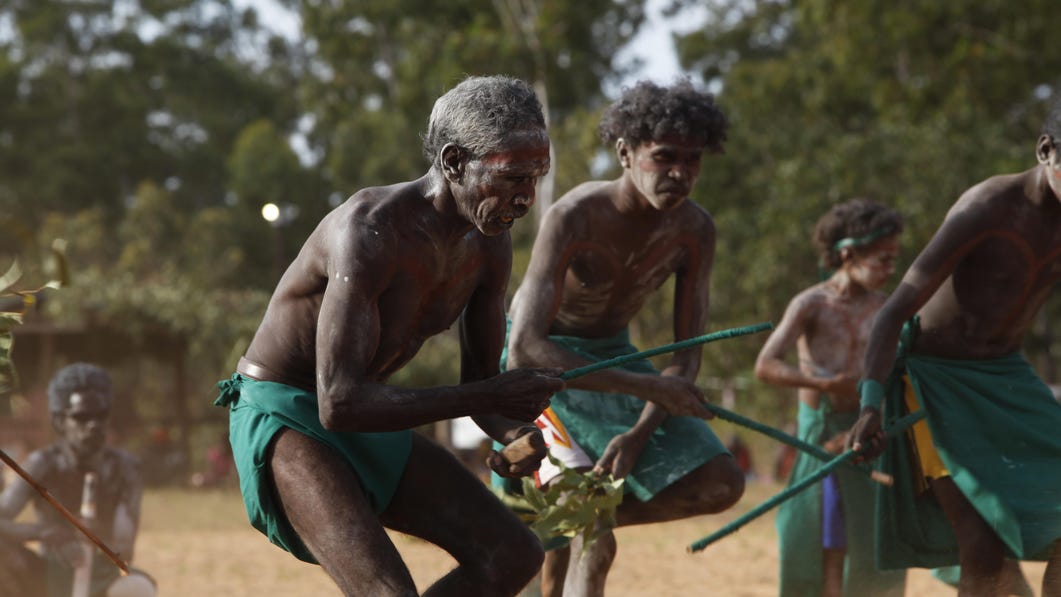
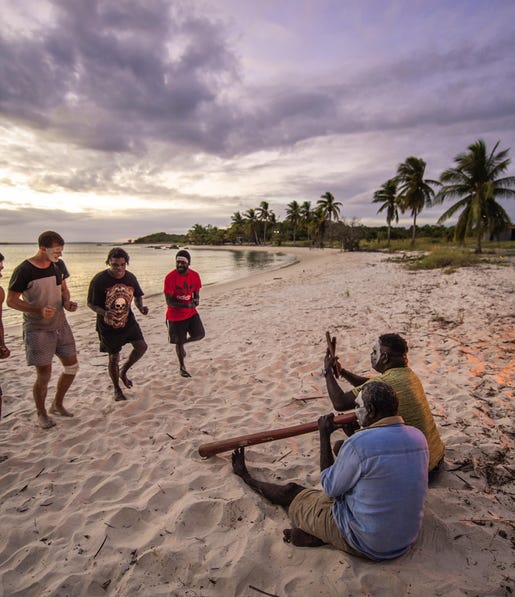
Traditional Aboriginal musical instruments
Fell in love with the music and the dance? Now learn more about the instruments behind it.
Clapping sticks
The bilma, or clapping sticks, are a part of the oldest songs of the Aboriginal people, often used as the rhythm for chants and melodies. Clapping sticks shows are frequent around Alice Springs and Darwin, and you can be sure to catch plenty of them at one of our annual festivals.
If you missed the festivals, the next best stop is the Karrke Cultural Experience Tours, held in the beautiful Watarrka National Park. These tours impart wisdom about not only the music and dance of the region, but how the land was used by the Aboriginal people for bush tucker, medicine and even to make musical instruments. Sign up to make your very own clapping sticks so you can keep the beat going when you get home.
Didgeridoos
First developed right here in the North of Australia about 1,500 years ago, the didgeridoo’s distinctive buzz is an enduring part of the songs and ceremonies of the Aboriginal people. While the instrument has an important role in Aboriginal culture, these days it can also be played casually around the campfire for guests as the unofficial soundtrack of the Top End.
If it’s not enough to just hear the music and you want to get involved in it, guests are in the right place. Didgeridoo lessons are offered across the NT, so whether you’re staying in Darwin, Katherine, Alice Springs or even camping around Uluru there’s plenty of opportunities to learn.
In the Dry Season, some of the finest in the country are manufactured at the Didgeridoo Hut and Art Gallery in Humpty Doo, less than half an hour outside Darwin city. Owned and operated by Indigenous Northern Territory artists and musicians, visitors have the opportunity to meet the maker of their instrument and hear the stories behind every piece sold. Just remember, these instruments are generally over a metre in length – so you might need to clear some space in your luggage.
Music & dance in Aboriginal culture
Song and dance are a vital, vibrant part of Indigenous culture today, both in exploring new musical styles and celebrating the traditions of old. This passion for dancing and traditional music has been a part of Aboriginal life throughout history, as the stories of ancestors are passed down. The music and ceremonies our guests can experience in the NT contain the preserved history of one of the oldest civilisations on the planet – and there’s nowhere it’s more celebrated than up here. To learn more about the history of the region’s music, visit one of our cultural centres, catch a show or check out one of our captivating musical tours.
Body painting
Body paint is also a part of these ancient Aboriginal traditions, as dancers use vibrant colours as a part of the storytelling in the songs. Drawn from the flowers and the clay of the land, this body art was traditionally applied by a dancer’s family, and could only be changed by a relative. Along with the music and dance itself, the paint was a showcase of the performer’s ancestors, spiritual beliefs and relationship with the land.
Tribes
Part of the reason for music and dance’s cultural significance is the role it played within the traditional Aboriginal tribe. As well as revered rituals such as bereavement and Dreamtime ceremonies, tribes used songs to celebrate seasonal changes and events such as weddings and initiations. Specific tribes had very different styles of music, and our guests are sure to find out plenty about the myriad of tribes that have populated the Top End during their stay.
Dance rituals
Dance rituals and ceremony are as meaningful and significant to Aboriginal culture as the music itself, and the NT is the best place to see one up close. Experience the colours and energy for yourself with a Lirrwi Tourism tour or the Culture College on Arnhem Land has a specialised tour for students.
Smoking ceremonies
Smoking ceremonies have been a traditional custom amongst the Aboriginal peoples for thousands of years, as native plants are burned to ward off evil spirits and ensure a prosperous future for the land and its inhabitants. Ceremonies promote spiritual well-being and physical health by combining traditional instruments and dancing.
If you’re lucky enough you might also experience a smoking ceremony as part of a Welcome to Country or Acknowledgement of Country. Often held before an event or activity, a Welcome to Country is a way to show respect to the traditional owners of the land. Recognising their cultural heritage, beliefs and connection to the land.
Dreamtime
Like the painting, sculpting and literature of the Aboriginal people, music and dance is traditionally a storytelling medium, used to pass down stories from generation to generation. This means that the ceremonies can often be sacred events for the local people.
Much of the traditional belief system of the Indigenous Australians relates to ‘dream tracks’, which are paths across the land or sky that ‘creator-beings’ followed during the ancient Dreamtime. These songs often describe the actual geography of the land and are the source of Aboriginal creation myths, as well as being the basis for the traditional names of everything from the rocks and trees of the land to the birds and animals they lived alongside.
Guests can get a glimpse into this tradition at a number of the arts festivals across the Northern Territory. Other places to learn more about the fascinating Dreamtime stories include the Crossing Country Cultural expedition or day tour through Gove Gululu.
Corroborees
Because of their role in Indigenous traditions, the many festivals listed above are likely our guests’ best chance to see a traditional Aboriginal dance ceremony that may otherwise be unavailable. Staging these customary songs in elaborate ceremonies is still a crucial part of Aboriginal culture, religious beliefs and social collaboration, which we in the Northern Territory are proud to help preserve. The ongoing importance of these ceremonial rituals and stories to Aboriginal culture means that invitations are generally required for outsiders to be present, however you can catch displays of this music and dance at the many cultural centres across the Northern Territory.
Although these ceremonies are usually kept private, several cultural centres across the territory have the unrestricted rituals on display if you’re interested. First stop should be the Winanjjikari Music Centre, a modern production house and a cultural centre preserving the culture of the land. You can check out a range of their talented musicians on Spotify or ABC Radio National online. The centre is also a superb opportunity for visitors to come and see a Corroboree ritual, chat with the artists behind it and learn more about one of the most enduring cultures on the planet – all to the sound of an authentic Northern Territory soundtrack.
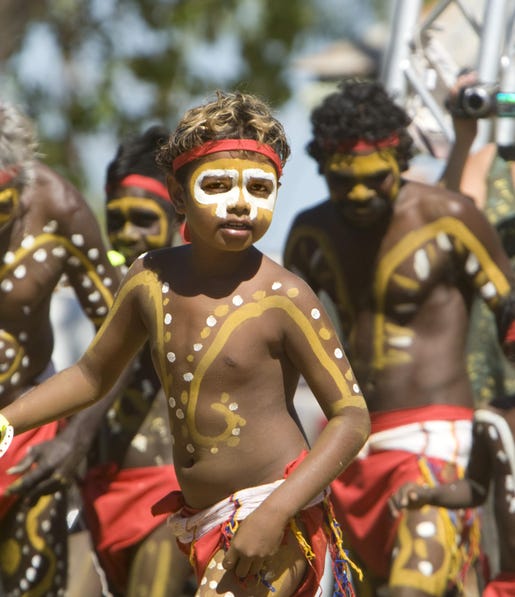
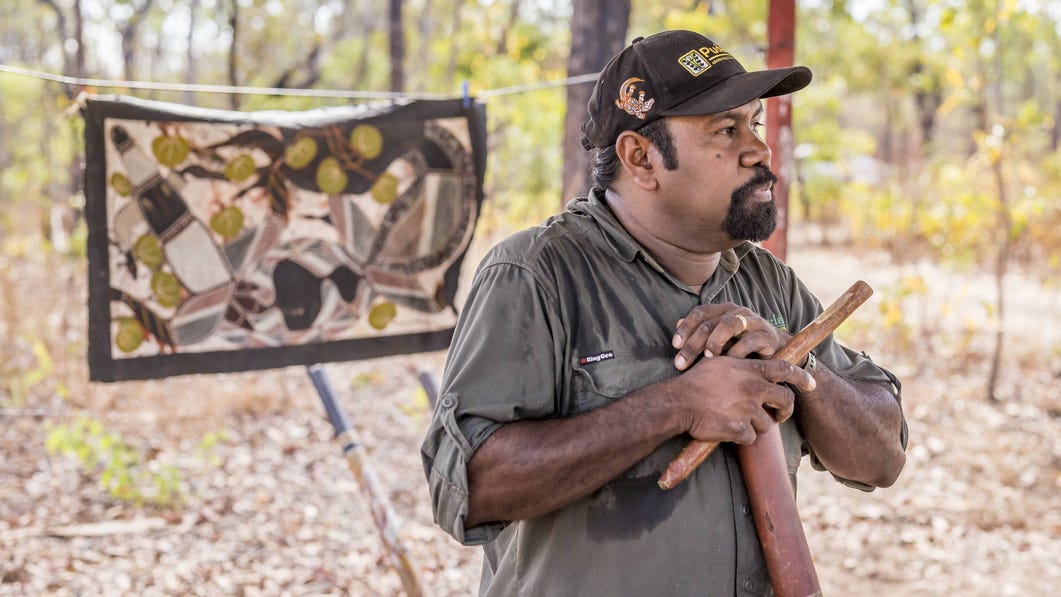
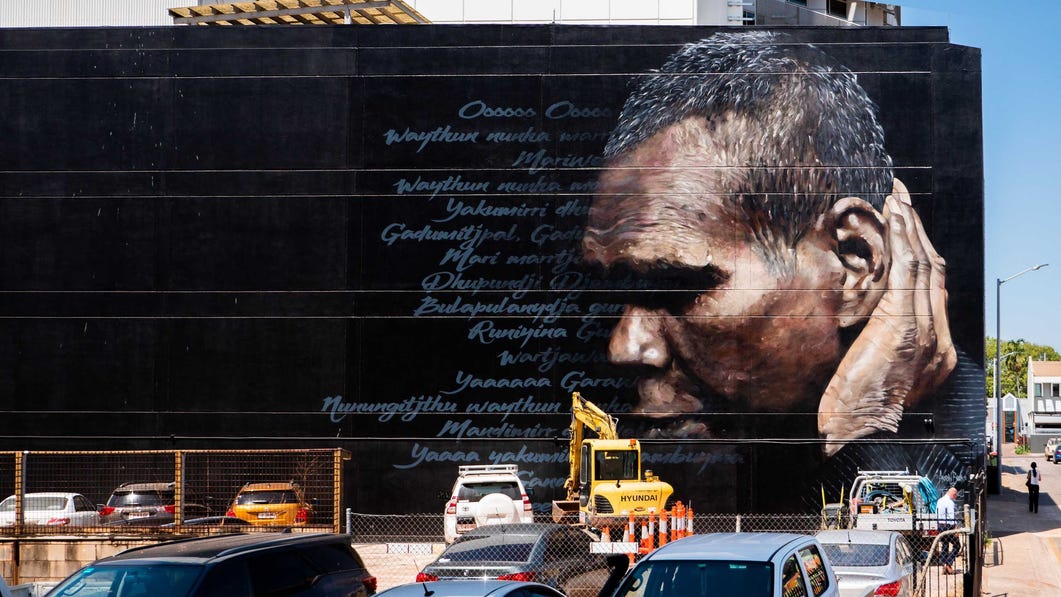
Contemporary artists of the NT
As well as the songs and music of generations past, there’s plenty of contemporary musicians from the NT to enjoy during your stay. Aboriginal and Torres Strait Islander readers are advised that the following section contains the names of people who have died.
Warumpi Band
Now disbanded but an important part of the musical history of our region, the Warumpi Band incorporated traditional didgeridoo and vocal work with a guitar-heavy, modern sound. The band was renowned not only for their music, but also how they drew attention to contemporary issues facing Indigenous Australians. With legendary songwriter Neil Murray as one of the founding members, the Warumpi Band are a great place to start to get a feel for the sounds of the Territory.
Jessica Mauboy
One of the success stories of NT R&B, Jessica Mauboy has gone double platinum in Australia since coming runner up on Australian Idol, but we’re glad to say she still comes back to her family home of Darwin from time to time. Australia’s guest contestant at the 2018 Eurovision Song Contest and NT Australian of the year for 2013, Jessica has proudly incorporated Aboriginal styles and traditions into her work for years.
Baker Boy
Famous for using both English and his native Yongu dialect in his rhymes, NT rapper Baker Boy had a massive 2019, with two songs in the Triple J Top 100, three ARIA nominations and winning the Young Australian of the Year award. Check him out and be sure to look out around the NT festival scene for other great local hip/hop acts.
Djuki Mala dance troupe
World famous after their viral performance in full ceremonial dress, the Djuki Mala dance troupe hails from the Elcho Islands, just off the coast of Arnhem land. They’ve been busy with multiple international tours and picking up a number of awards but you could just get lucky and catch them at a show around the Northern Territory while you’re here.
Yothu Yindi
One of the most unique musical groups to come out the of the Northern Territory, Yothu Yindi’s story could only have taken place up here. White rock group Swamp Jockeys were touring the Arnhem Land reserve in the 1980s, being supported by a local Yolngu band with traditional vocals, didgeridoos, clapsticks and dance. Loving the way they sounded together, the two groups joined to form Yothu Yindi, and have been playing ever since, entering the ARIA Hall of Fame in 2012.
Geoffrey Gurrumul Yunupingu
Dr D Yunupingu (referred to before his death as Geoffrey Gurrumul Yunupingu), was a member of the Yothu Yindi band before his passing, but reached the most people with his solo career. He spread the songs of his native Yolngu people to millions around the world and was one of the most celebrated Australian musicians of all time. The land and the people he sung about are what the music and dance of the NT are all about, and we’d love to share it with you.





